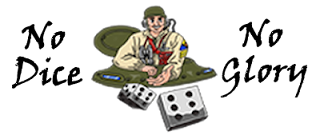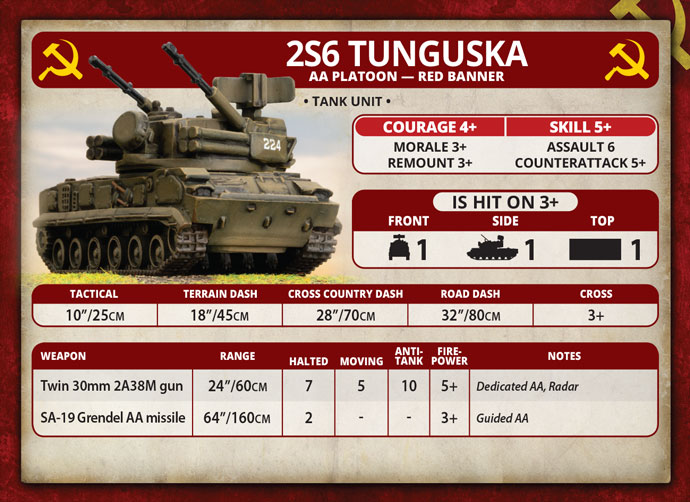Saturday, August 21, 2021
A New Platform
Sunday, January 31, 2021
Soviet AA Revisited - The Tunguska Edition
I updated my AA spreadsheet to include the Tunguska stats, and reran the cost-effectiveness calculation: which unit will do the most damage to a flight of typical NATO jets per point expended (click on the chart to get a higher resolution version). The Tunguska's guns come in as the third most cost-effective form of air defence, but suffer from occupying the same unit slot as the Shilka. If you are looking for long range air defence, the Tunguska's missiles on the other hand are terrible value for money - costing as much as a Gecko while losing a point of ROF.
This ability to fire both weapons at helicopters in sequential turns raises the question of which weapon should you fire in the enemy turn, and which in your own. The specific scenario I have looked at here is a pair of Tunguskas shooting at a pair of hunter killer helicopters (making the heroic assumption they are in range of both weapons), and compared it to an equivalent cost unit of Shilkas. In the turn which the helicopters fire, you shoot against a Concealed and Gone to Ground target, while in your turn they are only Concealed. Assuming the helicopters are in range of both weapons, is it better to fire the guns needing 6s and the missiles needing 5s, or vice versa? Overall it's better to fire the missiles at the Gone to Ground target, because the guns are just so much better at killing stuff that it's best for them to be hitting on 5s rather than 6s. So the question then becomes: can you afford to lose the teams that the helicopters are targeting? If yes, fire missiles then guns in order to have a higher chance of killing something across the two turns. If not, either fire the guns first to try and kill them before they get you, or better yet just spend the points on Shilkas. The final question I wanted to answer was how many points should I be spending on AA in my Soviet lists? Or more specifically, how much air defence do you need to be able to defend against four A10s?
- If Geckos get shot at, they die. Keep them concealed as best as you can.
- It's no surprise that the best protection comes from spending the maximum possible points across your three AA slots for quartets of Tunguskas, Gophers, and Geckos.
- For a given number of points to be spent on AA, it is more effective to spend those points on more platoons of cheaper weapons, rather than fewer platoons of better weapons. For example, four Shilkas and four Gophers are a more effective use of 8pts than four Tunguskas.
- My pick from the choices available for the best AA combination available to the Soviets would be a platoon each of Shilkas, Gophers, and Geckos.
- If you are simply looking at their AA performance, the Tunguska is too expensive, and the marginal increase in protection it offers is simply not worth the additional four points over a unit of Shilkas.
- Maybe they could have a role as an ambush unit? It would be kind of interesting to see what 28 dice at AT10/FP5+ would do to a LAV company. Apart from that, with Armour 1 they are not something that you should be relying on to kill ground targets unless you're desperate.
- I would only use the Tunguska for fluff reasons or because the model is cool. Which of course means that I need to get some Tunguskas.
Sunday, January 17, 2021
Seven Days to the River Rhine
The game is designed for 15mm and to suit Team Yankee basing. It's a smaller game than TY: set at reinforced platoon level, with activation by team.
The rules are brief at about 30 pages. The Facebook group has a FAQ/errata sheet, which is essential because there are a couple of places where the writing is a bit loose - particularly with shooting. There are embedded QR codes that link to tutorial videos on Youtube, which I think is an excellent touch.
Points are provided for a wide range of teams and nations, but apart from that there is no structure to support list building. Unit stats are relatively homogeneous across all of the nations, e.g. all infantry teams have the same stat line except some nations have slightly better morale.
We played 500pts on a 6x4 table, and completed the game in about 2.5 hours. This gave me six infantry teams, six BMP-1s, three T-64s, and two BRDMs. Pel had two Chieftains, two Swingfires, two Scimitars, three infantry teams in FV432s, a Milan team, a Marksman, and a Lynx. This was a good amount of equipment for the table size. Having more variety in his list seemed to work out well for him, and next time I’ll definitely run fewer infantry and a wider range of units.
- The initiative rules create a fantastic ebb and flow across the turn.
- Tanks die really easily.
- Infantry on the other hand are hard to kill. They can only be removed through the accumulation of morale markers, which takes either a long time or a significant concentration of fire.
- You never really have enough command tokens to do everything that you want, particularly when you start to lose teams. You need to think really carefully about what you want to do in the turn and concentrate your command tokens on doing that, rather than spending them reacting to your opponent.
- It gets really hard to do things mid game, as the accumulation of morale markers makes activation harder. Things just don't do what you want them to, which I think is a great mechanic.
Monday, January 04, 2021
2020 Retrospective
It's hard to do a hobby retrospective for 2020 without mentioning the pandemic. In New Zealand we were blessed that our remoteness gave the government time to put together a heavy-handed but effective response, combined with a whole lot of luck, which eliminated community transmission of the virus and allowed us to have a normal Christmas.
I managed to keep up with monthly posts until June, after which I totally overwhelmed with work and lacked the motivation and energy to do anything. In that time I did however manage a total of 13 posts, which was a significantly better effort than the year before.
The year was bookended by 100pt TY at ValleyCon and 60pt FOW-MW at Remember December. I ran T-64s at ValleyCon, placing fourth, and Afrika Korps panzers at Remember December, also placing fourth.
I didn't write about Remember December, nor take any photos, but as usual it was a great day. I ran a Panzer III company:
Panzer III Tank Company - Afrika Korps
Company HQ - 2 x Panzer III (short 5cm)
Panzer III Tank Platoon - 3 x Panzer III (short 5cm), 1 x Panzer III (long 5cm)
Panzer IV Tank Platoon - 2 x Panzer IV (short 7.5cm), 1 x Panzer IV (long 7.5cm)
Panzer II Light Tank Platoon - 3 x Panzer II
Total Cost: 60 pts
I thought the list would be terrible, but it was felt pretty good. I lost my first game against a US Rifle Company - I made the error of choosing Attack rather than Manoeuvre, which forced me into a No Retreat, losing because I didn't know that the newest version of the mission requires you to remain within 8" of an objective to keep the game going beyond Turn 6. I won the next two, against US Lees/Stuarts in Free For All (by the skin of my teeth and some very lucky Unit Last Stand tests), and a Panzer IV company in Encounter (confirming that the short 7.5cm is terribly over-costed).
I had a good spurt of painting FOW in the middle of the year, finishing most of the remaining models I had left for my Mediterranean British - two more platoons of armoured cars and platoons of Mk VIBs, Carriers, Vickers MGs, and 4.2" mortars. I didn't touch my TY Syrians.
I had three goals for 2020 relating to 28mm - painting and playing. I painted two squads of Perry Fallschirmjager, but did not play any games with them, nor did I do any work on the 28mm Landsknechts.
My most successful goal was to paint a Black Seas fleet box, which I changed during the year to be painting the Royal Navy ships required to play the Smugglers' Run campaign. I fell slightly short, needing just two more cutters to complete this fleet. With Warlord Games not having released a cutter model at the time (one is now available), I ordered some from Hagen Miniatures in June. Covid got in the way, with Deutsche Post spending much of the year not shipping to New Zealand, and I only received them in December.
I have decided to set fewer goals for 2021.
1. Field a T-80 company for Team Yankee. I have picked up the Soviet halves of a couple of the new TY starter sets, which are great value for the number of sprues that they contain, so need to paint them up and get them on the table.
2. Play a 1500pt game of 40K. I painted up about 400pts of Adeptus Mechanicus this year, so there's a bit of work needing to be done first.
3. Play through the Smugglers' Run campaign for Black Seas.
4. Administer a FOW ladder tournament for the club.
So happy new year, and thanks for reading the blog. Stay safe, and best wishes for 2021.















